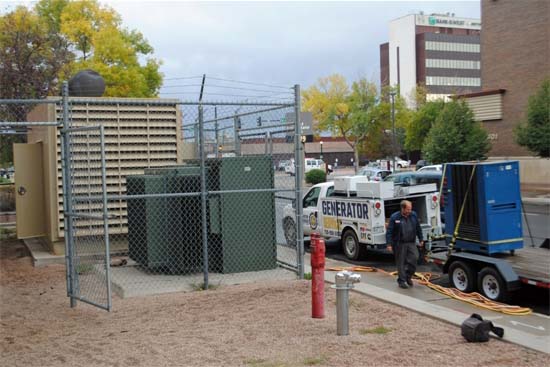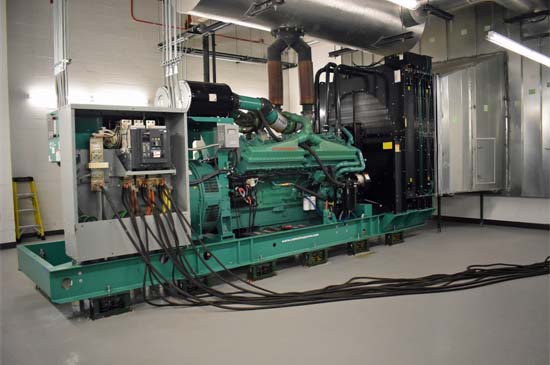Industrial and commercial generators are utilized in many different ways in today's high tech environments, from hypercritical power that can't be down for seconds to backup power for manufacturing facilities and small building, to mobile power modules used in remote fields and mountain areas. To meet the customer needs , generator manufactures have greatly expanded all the various options you can include. This article includes some of the core things buyers should understand and begin to think about before purchasing a generator.
Choosing the Correct Generator for Commercial Applications
A backup or continuous power system is comprised of a generator and supporting systems and equipment. The
National Renewable Energy Laboratory (NREL) conducted a study on the installation, maintenance and operation of the battery, diesel generator, and hydrogen fuel cell systems.
Diesel and Natural Gas (NG) generators are the standards. Chapter 4 Conclusions confirms that a diesel generator is still one of the lower cost options. However, it does not capture compliance with emissions and noise. Choosing the correctly sized generator and supporting equipment is essential when purchasing a new system or upgrading an existing system. A properly designed, installed, and maintained system provides years of reliable service. Generators are manufactured for both indoor and outdoor operation. Both of the applications offer a different set of considerations.
Outdoor Operation
Generators installed in sound attenuated containers are a popular solution for outdoor operations. These self-contained units that often include fuel tanks. Some installation factors include:
- Area Preparation - The generator cannot be located in an area with explosive gas. The unit must be placed on a level pad that meets generator weight specifications. Building structure must meet weight and vibrations requirements for rooftop mounted units. Generators located in harder access areas may require local permits.
- Installation - Loading, unloading, and shipping can vary depending on the size and generator proposed location. Once the generator, Automatic Transfer Switch (ATS), and other supporting components are then set, they are connected to the facility grid.
- Advanced Equipment - Paralleling control panels are used for multiple generator arrangements. Step-up or step-down transformers are used to reach needed voltage levels. Alarm and monitoring systems now have Wi-Fi and blue tooth functionality.
Indoor Operation
The engine, alternator, and cooling system are all mounted on a skid for these applications. They are considered complete generating units but must have fuel, cooling, and exhaust support systems. The generator support equipment needed for operation is dependent on the size of the operation. Some examples are:
- Fuel System - Main fuel tank, day tank, controllers, pumps, and piping throughout the system
- Cooling System - Building with outside air access can use an automated louver system connected to a radiator. If not available, heat exchanger systems that provide cooling an engine coolant system can be installed. Extra equipment and maintenance are needed for a heat exchanger system.
- Exhaust System - Engine must be routed outside through a muffler and exhaust pipe network.
- Building Safety - Fire protection, alarm and monitoring, and sprinkler equipment are installed in case of a space fire.
Paralleling control panels, switching and distribution, and uninterruptible power supplies are also common in many systems. Additional equipment is used for operations that require advanced backup or emergency power. It is not necessary for you to determine the equipment needed for your project.
Contact Us and we will help design your system, provide sales, installations services.
Maintenance & Repair Costs

Maintaining your generator reduces repair costs and ensures dependable power is available during utility outages. All generator manufacturers publish a planned maintenance schedule. The schedules slates maintenance to be performed on the generator set. It is divided into a calendar or hours of operation schedule.
The NREL publication included annual diesel generator maintenance costs at different operating time spans. The maintenance cost remained unchanged for diesel generators throughout the scale. Maintenance costs in all other systems increased with time used.
Monthly, quarterly, semi-annual and annual checks are normal manufacturer requirements. Often daily or hourly checks are performed on operating generator sets and their supporting equipment. Hospitals, data centers, and municipalities that have critical power requirements perform generator load testing. This test operates the generators at varying load percentages.
Generators and associated systems that do not have maintenance completed at prescribed intervals can suffer shutdown because of failure.
Lack of Maintenance Fictional Failure
The generator fails to start during a utility failure. The generator service agreement expired and was not renewed the previous year. Maintenance is performed by company force. Inspection reveals dead engine starting battery. The electrolyte level in the each of the battery cells was low and the battery charger circuit breaker was tripped. Battery electrolyte level brought increased with distilled water. Charger circuit breaker reset. Battery accepts charges and completes charging cycle. The next power failure generator fails to start. Low battery again.
The specific gravity of each battery cell was not checked, and it was not load tested. Battery fails load testing and is replaced. Maintenance procedures include checking the battery specific gravity and the charging system. Low electrolyte level contributed to the initial battery failure. The omission of this inspection resulted in the lack of emergency power during two separate utility failure events. The downtime and additional repair cost of the battery could have been avoided with a complete maintenance schedule. Unscheduled repair and maintenance costs can be reduced by entering a service contract with a qualified company. We offer service contracts, troubleshooting and repair, and installation services. We have expanded our Colorado Service to serve customers nationwide. Contact us at
Generator Source for more information.
Operation Costs During A Power Failure
These costs are attributed to operating under a loss of power. Fuel for the generator engine is a primary cost. Each manufacturer publishes a fuel consumption chart. Charts vary but most divide the amount of fuel used by the engine under varying load conditions. Go to
Cummins Generator Data Sheet for an example of a fuel consumption chart.
Fuel and delivery prices can rise during long-term outages. Installing extra tanks can eliminate the extra cost and wait during an extended outage. Facilities that have critical power requirements often have a maintenance staff to perform operational checks. The checks are often visual on the generator and supporting systems. Checks and extra fuel contribute to added costs but add dependability and allow for longer operational periods.
Generator Condition
Engine fuel consumption is directly proportional to the condition of the generator as a whole. The set consists of the engine and the alternator. Each is a system of moving components, and all moving parts wear. The engine will use more fuel when parts begin to reach their wear limits.
Generators that are supplying motors that are failing experience more wear. The engine and alternator both experience extra wear during this condition. As the symptoms increase the amount of fuel, consumption will increase. Once the motor completely fails, the system circuit breaker will trip removing the condition.
Summary
There many factors that contribute to the cost of a power system. The diesel generator is the most affordable in acquisition, installation, maintenance, and operation. The cost of an emergency or backup power system is minimal when compared to the loss of power to a facility with critical power needs. Having a properly designed, installed and maintained system will reduce operating costs and increase dependability.
>>Back to Articles & Info<<